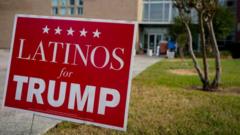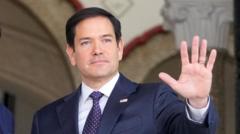In the recent election, Donald Trump's candidacy surprised many as it energized both Latino voters and the white working-class base that had initially propelled him to power in 2016. This unexpected shift in voter dynamics, particularly in key battleground states, indicates a recalibration of traditional political alliances and priorities.
Trump's Unexpected Rise: The Latino Shift and Working-Class Coalition

Trump's Unexpected Rise: The Latino Shift and Working-Class Coalition
Former President Donald Trump secures a surprising electoral win, raising eyebrows with increased Latino and working-class support.
In his victory speech delivered in Florida, Trump celebrated the coalition he formed, claiming it to be "the biggest, the broadest, the most unified coalition" in American history. He highlighted that support came from diverse groups, including union workers and various ethnic communities. The results in Pennsylvania, Michigan, and Wisconsin—states that were crucial for President Joe Biden's win in 2020—demonstrated this shift. Trump secured all three states this election, partly due to a notable increase in Latino voter support; in Pennsylvania alone, Trump saw a 42% backing from Latinos, significantly up from 27% in 2020.
In areas where Latino populations have been growing, like Pennsylvania's "Latino belt," many voters expressed a preference for Trump's approach to critical social and economic issues. Samuel Negron, a state constable from the Puerto Rican community in Allentown, stated, "It's simple, really. We liked the way things were four years ago." Common sentiments among voters included dissatisfaction with inflation and the rising cost of living under the Biden administration.
The desire for stricter immigration policies also played a vital role, particularly among Venezuelan-Americans who resonated with Trump’s assertions against perceived "socialist" policies. Many Latinos expressed a preference for aligning with what they believe to be family values that more closely mirror Republican principles.
The shift wasn't limited to Latino and white working-class voters; Trump also gained ground among younger voters and African Americans. In Wisconsin, while Joe Biden had a substantial 24-point advantage in 2020 among voters under 30, Trump's deficit reduced to 11 points, a significant turnaround. Additionally, his backing in urban centers, particularly among Black Americans, increased from 8% to 22% in parts of Wisconsin.
COVID-19 economic repercussions were felt deeply, prompting many to pivot towards Trump's economic messaging, which resonated particularly in Michigan's rural regions. Local voters voiced concerns over high interest rates and inflation, with many believing that Trump could provide solutions to their economic struggles.
As the dust settles from the election, political analysts are pondering how Democrats can reclaim their foothold among these crucial voter demographics that have historically leaned blue. With Trump's coalition gaining strength, understanding these shifts in voter priorities could be pivotal for the future of American politics.
In areas where Latino populations have been growing, like Pennsylvania's "Latino belt," many voters expressed a preference for Trump's approach to critical social and economic issues. Samuel Negron, a state constable from the Puerto Rican community in Allentown, stated, "It's simple, really. We liked the way things were four years ago." Common sentiments among voters included dissatisfaction with inflation and the rising cost of living under the Biden administration.
The desire for stricter immigration policies also played a vital role, particularly among Venezuelan-Americans who resonated with Trump’s assertions against perceived "socialist" policies. Many Latinos expressed a preference for aligning with what they believe to be family values that more closely mirror Republican principles.
The shift wasn't limited to Latino and white working-class voters; Trump also gained ground among younger voters and African Americans. In Wisconsin, while Joe Biden had a substantial 24-point advantage in 2020 among voters under 30, Trump's deficit reduced to 11 points, a significant turnaround. Additionally, his backing in urban centers, particularly among Black Americans, increased from 8% to 22% in parts of Wisconsin.
COVID-19 economic repercussions were felt deeply, prompting many to pivot towards Trump's economic messaging, which resonated particularly in Michigan's rural regions. Local voters voiced concerns over high interest rates and inflation, with many believing that Trump could provide solutions to their economic struggles.
As the dust settles from the election, political analysts are pondering how Democrats can reclaim their foothold among these crucial voter demographics that have historically leaned blue. With Trump's coalition gaining strength, understanding these shifts in voter priorities could be pivotal for the future of American politics.























